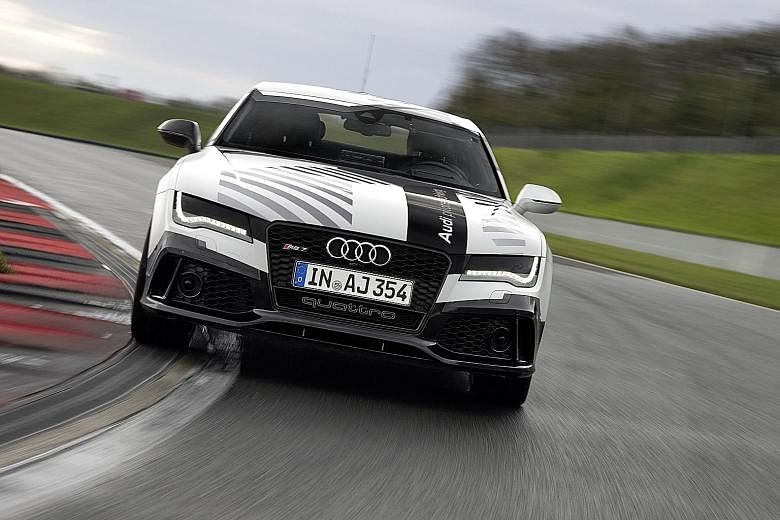Your eyes are not mistaken - the Audi RS7 pictured here tackling a race circuit does not have a driver.
I could not believe my eyes either when I saw the prototype perform autonomously at Spain's Castelloli Racetrack. A driver drove it to the start grid, exited the vehicle, then remotely activated its run from the outside.
The driverless RS7 took off aggressively, with its turbocharged 560bhp V8 engine and loud exhaust pipes roaring. It braked hard and fast for the first turn about 200m from the start grid and continued with a wide open throttle.
It moved and sounded like a racing car in action, but without a racing driver inside. Spooky, but thought-provoking.
After getting over my fear of Pixar movie Cars (2006) becoming an eerie reality in my lifetime, my first thought was: Is Audi's "autopilot" prototype faster than one helmed by a driver on this track?
I was going to drive a standard RS7 on the same track to compare my lap time with that of the special RS7 that handled the track with nobody onboard. Before that, I would take a ride in its similarly capable sister vehicle.
I was not alone, though. And I'm not referring to the "robot" somewhere inside Robby (the name of the autonomous RS7 I would be riding in).
For safety reasons, there was a test driver behind the wheel. After he drove Robby to the start grid, he took both hands off the steering wheel, flipped a switch on the centre console and held a trigger device in his right hand, thumb hovering above the top button.
"Ready?" he asked.
The driver depressed the button and held it there (the system would stop its automated driving mode if the button was released).
Robby did not dilly-dally. It went racing right away - working the V8 engine and gearbox hard, hammering the carbon-ceramic brakes before each turn and taxing the high-performance tyres throughout.
It aimed at and clipped every apex on the 12-turn track. It steered, accelerated and "jambraked" like it was trying to set a good lap time.
Robby was one of the most determined "drivers" I've sat with on a circuit.
According to Mr Klaus Verweyen, head of pre-development of automated driving functions in Audi, Robby operates at the limit of its (ample) grip and (all-wheel-drive) stability on the track.
He said: "A fast race lap is not our main focus of development, so we didn't overdo it. We're calculating new functionalities for our customers. If a professional racing driver drives a lap on the same track with a standard RS7, we think he can be a little faster.
"If you're an experienced driver, you can drive faster than Robby, don't be afraid."
But I was afraid. Because I wasn't aided by any of the high-tech equipment that made Robby so good on a racetrack.
I could rely only on common sense instead of sensors, my bespectacled eyes instead of allseeing cameras, and a rough idea of the circuit's layout instead of accurate GPS data.
Robby's lap time was just under 2 minutes and 9 seconds. I was about half a second quicker in a regular RS7. This average man was a little faster than the above-average machine.
More importantly, Audi's state-ofthe-art "autopilot" technology is faster and further ahead than transport legislation and traffic infrastructure on the long road to autonomous motoring.
•The writer is the editor of Torque, a motoring monthly published by SPH Magazines.

